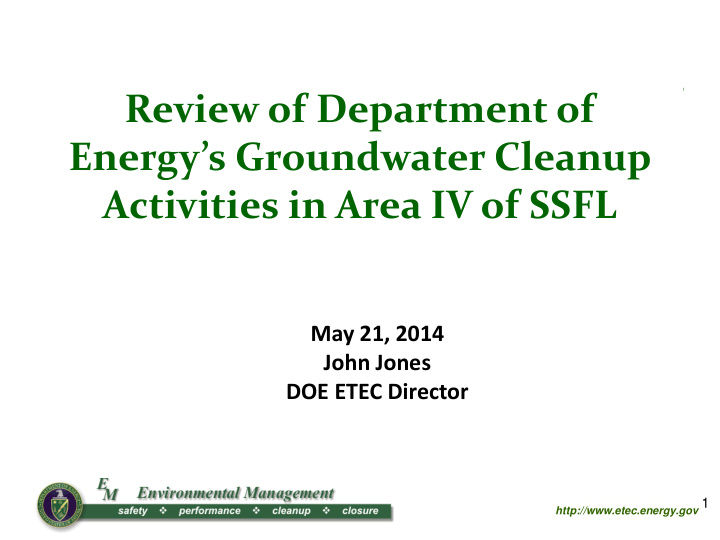



Review of Department of Energy’s Groundwater Cleanup Activities in Area IV of SSFL May 21, 2014 John Jones DOE ETEC Director 1 http://www.etec.energy.gov
Groundwater Characterization • First monitoring well installed in Area IV in 1984 • Since then, 96 monitoring wells have been installed • Trichloroethylene (TCE) is the common groundwater contaminant in Area IV • There are localized areas with contamination by: – Perchlorate – Strontium-90 – Tritium 2 http://www.etec.energy.gov
Area IV Groundwater • Two parts to Area IV groundwater studies – USEPA completed sampling for radioactive materials in groundwater in 2011 – DOE’s groundwater investigation focuses on three areas: • Former Sodium Disposal Facility (FSDF) • Tritium plume • Radioactive Materials Handling Facility (RMHF) 3
Groundwater Data Gap Exercise • DOE recently completed a groundwater data gap exercise that involved: – Identification of groundwater impact sources – input locations – Adequacy of the well network to define impacted areas 4 http://www.etec.energy.gov
2014 Groundwater Sampling • Recommendations from the data gap exercise were used for the February 2014 sampling effort • Many of the shallower wells were dry in February due to the ongoing drought • DOE is in the process of sampling soil gas for volatile chemicals (TCE) to see if any sources remain in Area IV 5 http://www.etec.energy.gov
TCE in Groundwater • The most impacted location is at the Former Sodium Disposal Facility (FSDF) • Soil cleanup at the FSDF removed shallow contamination but left TCE in bedrock • Groundwater pump and treatment from 1995 to 2002 reduced TCE concentrations by about 50% • DOE plans to resume the pump and treatment action to reduce levels further in the later part of this year 6 http://www.etec.energy.gov
Tritium Plume • Groundwater in north central Area IV is impacted by Tritium and is located near Buildings 4019, 4059 & 4100 • Monitoring data for the past 10 years show the plume to be degrading consistent with the half-life of Tritium (12.3 years) 7 http://www.etec.energy.gov
Tritium Plume 8 http://www.etec.energy.gov
Tritium Plume 9
Strontium-90 • The former leachfield by the Radioactive Materials Handling Facility is impacted where liquid Strontium-90 wastes were released in the 1960s o The leachfield and contaminated soils were removed o Sr-90 contamination moved into the bedrock below the leachfield • University of Guelph will be drilling an additional core hole this month to evaluate depth of Sr-90 in bedrock • A new well will be installed to define the boundaries of Sr-90 groundwater contamination. http://www.etec.energy.gov 10
Seeps and Springs • The groundwater model for Area IV indicates that contamination remains in the upper bedrock zone and it is migrating laterally to the sides of the mountain, thus seeps are something we will continue to monitor • For Area IV, groundwater flow is primarily to the northwest • DOE has sampled seeps north and northwest of Area IV for the presence of TCE and Tritium • DOE has had seep well clusters installed in the expected pathways of the plumes to monitor for presence of contaminants http://www.etec.energy.gov 11
Summary • DOE is committed to meet its GW obligations per the 2007 Consent Order. • DOE will complete the soil vapor study & Sr-90 source characterization. • DOE will perform Pump and Treat in the near term, it has shown to be effective at removing shallow TCE contamination. • DOE will continue to monitor the Tritium plume & associated Seeps as we develop an understanding of the GW in Area IV. • All of the Area IV data show contamination to remain shallow, not moving towards aquifers that are used for water supply. 12
Recommend
More recommend